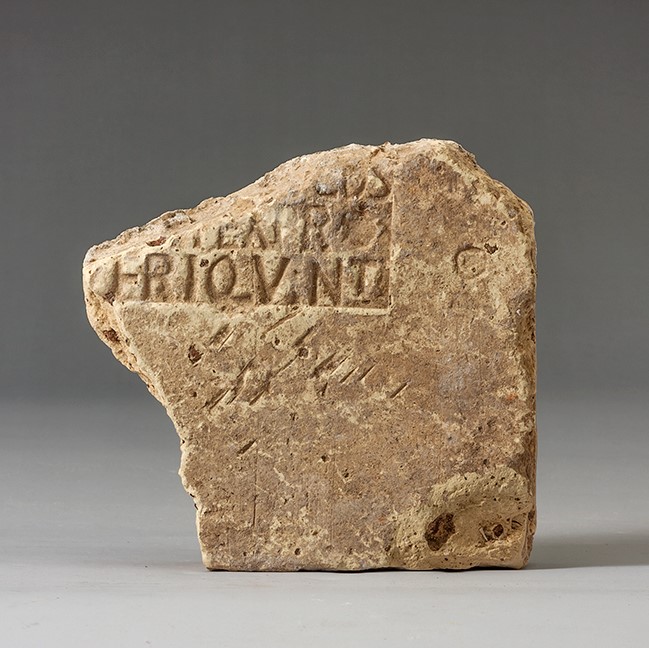Acquisition number: 2008.05
Cream-buff clay with many dark inclusions and voids. The bottom and right edges are preserved. On the smoothed upper face of the brick is the lower right part of the impression from a rectangular stamp:
]COS
]TEXPR•
]ERIQVINT
APRON ET PAETIN COS
POMP VIT EX PR•
ANNI VERI QVINT
for Apron(iano) et Paet(ino) co(n)s(ulibus) Pomp(onii) Vit(alis) ex pr(aedis) Anni Veri Quint(anesibus).
Title: Fragment of a Stamped Roman Brick - 2008.05
Acquisition number: 2008.05
Author or editor: J.R. Green
Culture or period: Roman Imperial
Date: AD 123
Material: Clay - Terracotta
Object type: Architectural features
Dimensions: 37mm (l) × 133mm (w) × 123mm (h)
Origin region or location: Italy
Origin city: Rome
Display case or on loan: 6
Keywords: Roman, Imperial, Brick Stamp, Stamp, Fragment, Apronianus, Paetinus, M Annius Verus, Lady Helen Blackburn
2008.05
Fragment of a Stamped Roman Brick
Presented by Lady Helen Blackburn. Max. dim. 12.3 x 13.3 x 3.7cm.
Cream-buff clay with many dark inclusions and voids. The bottom and right edges are preserved. On the smoothed upper face of the brick is the lower right part of the impression from a rectangular stamp:
]COS
]TEXPR•
]ERIQVINT
APRON ET PAETIN COS
POMP VIT EX PR•
ANNI VERI QVINT
for Apron(iano) et Paet(ino) co(n)s(ulibus) Pomp(onii) Vit(alis) ex pr(aedis) Anni Veri Quint(anesibus).
M. Annius Verus was a distinguished figure, grandfather of Marcus Aurelius, consul three times, and praefectus urbi in the years AD 121-125; on him, see the good note in Oxford Classical Dictionary3, and then P. Setälä, Private Domini in Roman Brick Stamps of the Empire. A Historical and Prosopographical Study of Landowners in the District of Rome (Helsinki 1977) 56-58, J.P. Bodel, Roman Brick Stamps in the Kelsey Museum (Ann Arbor 1983) 34 no. 41. The latter also refers to the praedia Quintanensia under his item 40.
The date of manufacture is (supposedly) the same as 1977.05 and 1978.02. See the discussion of this series by Bloch, Bullettino della Commissione Archeologica Comunale di Roma 66, 1938, 72-78.
The piece was collected probably in 1935 while the donor was based in Rome, but the site is not recorded. Lady Blackburn (1918-2005) seems to have been an avid collector of objects found under foot, and she formed a large collection of seashells, particularly in the Darwin area (see her Marine Shells of the Darwin Area [Darwin: Museums and Art Galleries Board of the Northern Territory, 1980?]). Many of them are now housed in the National Museum of Australia; her papers are in the National Library. She had learned to fly in 1944 and remained an active pilot; she often flew with her husband to remote localities in the Northern Territory. They had married in 1951, and her husband, Sir Richard Blackburn, was Pro-Chancellor (1976-84) and Chancellor (1984-87) of the Australian National University.
